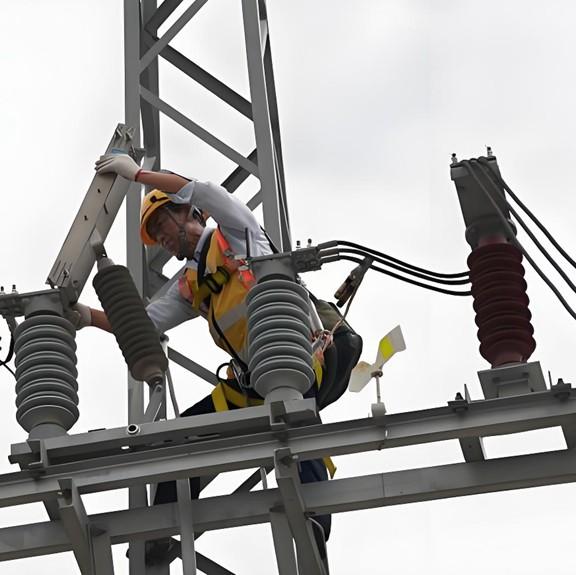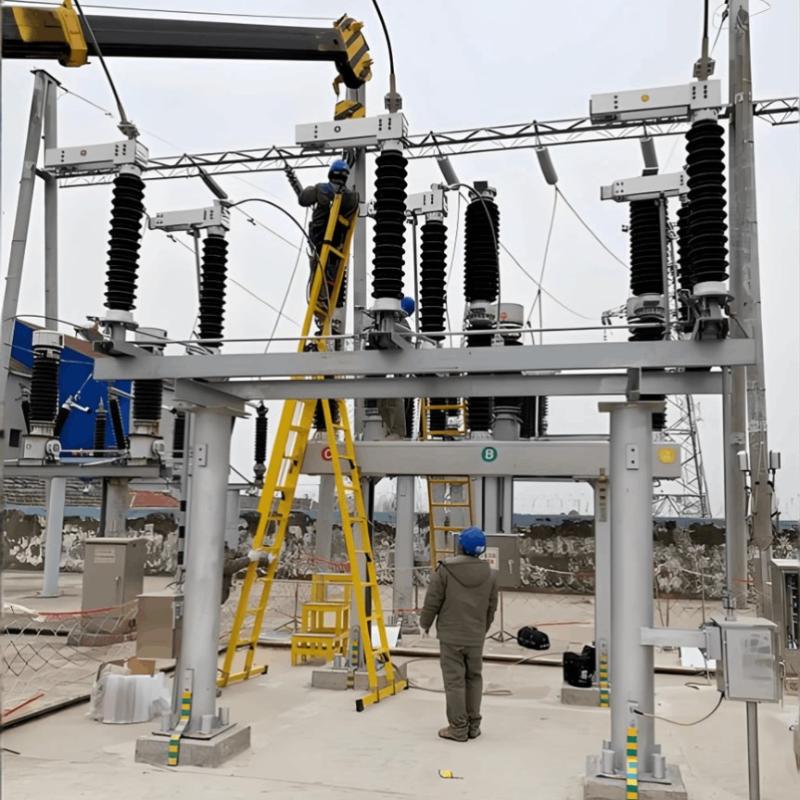Ang disconnector mao ang labing gamit nga tipo sa high-voltage switching equipment. Sa mga sistema sa kuryente, ang mga high-voltage disconnectors mao ang mga high-voltage electrical devices nga gigamit sa pagkombinado sa high-voltage circuit breakers aron makapagbuhat og switching operations. Sila may papel nga importante sa normal nga operasyon sa sistema sa kuryente, switching operations, ug maintenance sa substation. Tungod sa ilang paborito nga paggamit ug mataas nga pangutana sa reliability, ang mga disconnector nagpabug-at sa disenyo, pagtukod, ug safe operation sa mga substation ug power plants.
Ang operating principle ug structure sa mga disconnector kasagaran simple ra. Ang ilang primary nga characteristic mao ang wala silay capability sa arc-quenching; sila makapagbuka o mag sulay sa circuits lang sa no-load current o kaayo ka baho nga current conditions (kasagaran < 2 A). Ang mga high-voltage disconnectors mahimong ikategoryan batas sa installation environment isip outdoor o indoor types. Batas sa structure sa ilang insulating support columns, sila mahimong ikategoryan pa isip single-column, double-column, o triple-column disconnectors.
Ang 220 kV substation sa usa ka power plant sa usa ka aluminum enterprise mao ang usa ka fully automated step-down substation nga adunay na 19 ka tuig na ang operasyon. Iliya gipanghatag ang DC power sa 200 kA electrolytic cells ug gipanghatag usab ang production, auxiliary, ug residential power sa uban pang secondary plants sa kompanya. Ang outdoor 220 kV switchyard gigamit ang GW7-220 type outdoor AC high-voltage disconnectors—three-column, horizontally opening, three-phase, 50 Hz outdoor high-voltage electrical equipment.
Tungod sa commissioning niadtong 1998, ang mga outdoor AC high-voltage disconnectors naka enable sa bus transfer sa no-load conditions ug naka provide sa electrical isolation tali sa de-energized equipment ( sama sa busbars ug circuit breakers nga under maintenance) ug live high-voltage lines. Pagkatapos sa 19 ka tuig sa serbisyo, gi observe ang widespread overheating sa mga contact sa disconnector (infrared thermometer readings reaching up to 150°C), nga naghatag og serious nga safety hazard. Kini nga problema mahimo molon sa burnout sa 220 kV disconnectors, resulta sa phase loss, contact welding, o arc-flash short circuits—potentially causing a complete blackout ug paralysis sa tanang substation system.
Isip tugon, ang data collection ug root cause analysis gisagol, leading to the identification of the primary causes of contact overheating. Effective retrofit measures giatiman ug subsequently promoted for broader application.
Structure and Operating Principle of the GW7-220 Outdoor AC High-Voltage Disconnector
Kini nga disconnector adunay three-column, horizontally rotating structure, consist of a base, insulating support columns, a conductive system, an earthing switch (except for non-grounded versions), and a drive mechanism. The base is welded from channel steel and steel plates, with three mounting brackets: two fixed at the ends and one rotatable in the middle. Inside the channel steel housing are transmission linkages and interlocking plates. Mounting plates are welded beneath the base for secure foundation attachment. Bases are available in three configurations: non-grounded, single-grounded, and double-grounded. For grounded versions, earthing switch brackets are welded to one or both ends of the base, with earthing switches mounted accordingly, selected based on circuit requirements.
The conductive assembly is fixed atop the insulating columns and comprises a moving blade (conductive gate knife) and stationary contacts. The gate knife consists of two copper tubes connected via two copper blocks to an aluminum cover, with a cylindrical contact tip welded at the end. The stationary contacts feature a finger-type, multi-point contact design. Each contact finger has an independent tension spring, providing sufficient insertion travel to maintain reliable contact even under busbar tension forces. A return spring tilts the stationary contact slightly to ensure smooth and coordinated opening/closing actions.
The operating mechanism includes both electric and manual options. The electric mechanism uses an asynchronous motor driving a mechanical reduction gear to rotate the main shaft by 180°. Force is transmitted via connecting steel tubes to the disconnector, and linkages rotate the central insulating column by 71°, causing the moving contacts at both ends of the conductive rod to insert into or withdraw from the stationary contacts, completing closing or opening operations. Mechanical dead-center positions in the linkage provide self-locking at the end points of travel. Manual operation is available for commissioning or in case of electric mechanism failure.
Analysis of Contact Overheating Causes in Outdoor High-Voltage Disconnectors
The aluminum enterprise’s 220 kV outdoor switchyard has 24 sets of GW7-220 disconnectors serving two 220 kV incoming lines, rectifier units #1–#4, and power transformers #1 and #2, totaling 144 stationary contacts. During routine inspections, overheating was assessed by observing heat shimmer, discoloration, or temperature measurements exceeding 70°C at contact points. Statistics show that from January to December 2014, there were 13 unplanned outages due to disconnector contact overheating—averaging 1.08 incidents per month.
Repeated testing and analysis of contact dynamics revealed the following root causes:
Each stationary contact consists of six independent finger contacts with point-contact geometry, resulting in insufficient total contact area and uneven current distribution across fingers—a structural flaw.
Multiple movable contact components allow current to flow through contact springs, causing annealing, loss of elasticity, reduced contact pressure, and worsening contact resistance, which exacerbates heating.
Harsh outdoor conditions (sunlight, rain) combined with suboptimal material selection (standard steel for tension springs and contact pins) led to severe corrosion, aging, spring fatigue, degraded mechanical properties, insufficient contact force, and excessive loop resistance.
Arc erosion has caused pitting and severe oxidation on contact surfaces, further increasing resistance.
Retrofit and Preventive Measures for Stationary Contacts
Interconnect the originally independent finger contacts using flexible copper straps to increase effective contact area between moving and stationary contacts.
Pwahon ug i-angkon ang mga tension spring ug pins aron mapadako ang puwersa sa spring ug mapabati ang pagkakontak.
I-apply ang plating sa pilak sa tanang mga moving ug stationary contact surfaces.
I-apply ang solid lubricant sa mga contact surfaces aron mapababa ang friction ug maprevent ang oxidation.
Implementa ang infrared temperature monitoring, kasagaran sa mga contact connection points, ug buhaton og temperature database.
Himo og regular nga maintenance, inspection, ug paglimpyo sa mga disconnectors.
Verification ug Application Results
Ang post-retrofit monitoring nagpakita:
Sa parehas nga ambient temperature (17°C) ug operating conditions, ang temperatura sa mga contact gibabawas gikan sa ~23°C (unmodified) ngadto sa ~19°C (retrofitted).
Ang visual inspections sa panahon sa maintenance nagpakita og significantly fewer arc-damage spots sa retrofitted contacts konpared sa unmodified ones.
Hangtod karon, 5 ka disconnector units (30 stationary contacts) gi-retrofit na. Kini nga teknikal nga solusyon gi-implementar na sa tanan nga GW7-220 disconnectors sa 220 kV outdoor switchyard sa kompanya.
Conclusion
Pinaagi sa systematic nga analysis sa widespread nga overheating sa contact sa GW7-220 outdoor AC high-voltage disconnectors, ang targeted modifications sa stationary contacts mahimong ma-develop ug implementar. Kini nga initiative naka-enhance sa power supply safety ug operational stability, samtang naghatag usab og valuable experience alang sa future operation, maintenance, ug servicing sa GW7-220 disconnectors.






















